Sooner than you think, you will be a technician in the automotive service repair industry. As far as your shop manager is concerned, you better understand the value of the customers. And, at the same time, you better know how to provide that customer value by your repairs. In this case, we will discuss what is involved in restoring brake systems to like-new condition.
What is True Value?
So how much does a brake job cost? Just like buying a meal where you can choose from fast food or fine cuisine, the price of a brake job depends on what you want. So it is with a brake job. The only difference is, most of your customers wouldn’t think of paying fast food prices for a class “A” meal. However, they might expect a complete, professional brake job for a “slap-some-pads-on-it” price. Often, that’s not all their fault. They’re inundated with ads for low-ball brake jobs. They just don’t know there’s a difference. That’s why a complete brake job usually needs to be sold.
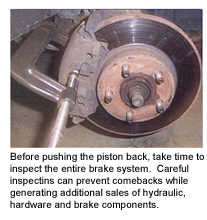 The customer will not ask you for a complete brake job, and you can’t quote a price until the vehicle has been test driven and inspected. As always, start out by querying the customer about their concern. Next, test-drive the vehicle to verify the problem and perform a complete brake inspection in the bay. Most people know about brake pads and shoes. Unfortunately, what they know about them is that they’re on sale at the local chain parts store for $8.99 as advertised in their Sunday newspaper. We need to explain the difference in the quality of the friction materials, the completeness of the pad set (shims, clips, etc.) and show them why it is beneficial to them to buy the higher quality pads.
The customer will not ask you for a complete brake job, and you can’t quote a price until the vehicle has been test driven and inspected. As always, start out by querying the customer about their concern. Next, test-drive the vehicle to verify the problem and perform a complete brake inspection in the bay. Most people know about brake pads and shoes. Unfortunately, what they know about them is that they’re on sale at the local chain parts store for $8.99 as advertised in their Sunday newspaper. We need to explain the difference in the quality of the friction materials, the completeness of the pad set (shims, clips, etc.) and show them why it is beneficial to them to buy the higher quality pads.
The same goes for a complete brake job. We must explain the benefits to the customer if they buy the complete brake job. Benefits such as safety, smooth braking, quiet operation and longevity. Remember that customers buy benefits, not features. So, don’t get too technical.
Getting Started
OK, so how do we restore a brake system to like-new condition? That means that the brakes should work as designed when the car was new. That means that drums, rotors, pads, shoes, hardware, calipers, wheel cylinders, master cylinders, hoses, proportioning valves, parking brakes, vacuum booster or hydraulic assist and ABS systems all work correctly. Perhaps even more importantly, that they will continue to work for many more miles. So, while we can’t condemn a wheel cylinder as defective if there is a trace of brake fluid dampness around the dust boot (it’s not leaking), we can recommend replacing it before it does leak and contaminate the brake shoe lining.
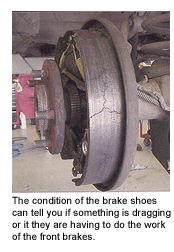 The benefits to the customer include:
The benefits to the customer include:
Less labor (money) to replace the wheel cylinder while replacing the shoes;
The new shoes won’t get contaminated and need replacement before they’re worn out;
The wheel won’t grab or lock up as it might with contaminated shoes;
Less overall cost in the long run; and
Avoidance of another trip to your shop.
The Value of Your Expertise
Most reasonable people would see the value in this and heed your advice. Parenthetically, let me add that at our shop, we charge the customer for a complete brake inspection, regardless of whether the inspection leads to needed work, or we find that all is OK. There is value in a properly done inspection. It takes time, and we should be compensated for it. If all you’re going to do is peek through some open-spoke wheels to get a glimpse of the pad thickness, don’t expect the customer to pay for that. It’s worth virtually nothing. A complete inspection should include a check sheet for the technician to fill out as he’s inspecting the brakes. This ensures that nothing is missed, and reassures that customer that something was done for the money they spent.
More on Inspections
Brake pads should be inspected for integrity (friction material still bonded or riveted to the backing plate), lining thickness, cracks, and evenness of wear. We always quote friction material thickness as a percentage of the lining remaining versus a new pad. With all of the different vehicles, drivers and driving styles, I wouldn’t want to try to predict the amount of miles left on the pads. Let the customer extrapolate the mileage based on previous brake jobs or the mileage at the time the pads were last replaced.
Caliper hardware should be examined for fit, corrosion and wear. Rusted hardware can cause pulling and uneven pad wear. Worn hardware can cause clunking, knocking or clicking noises as the caliper or pads move excessively. New hardware is cheap insurance against a comeback. Caliper pistons should push back smoothly into their bores. And, please open the bleeder screw first, so that dirty brake fluid will not be pushed back into the system. This is especially important with ABS-equipped vehicles. You don’t want to hang a valve in the hydraulic control unit with a piece of debris from the caliper. Caliper boots and rubber parts should be soft and not torn.
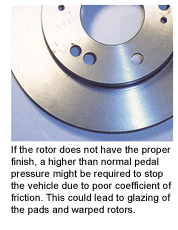
The parking brake should hold the vehicle when parked, and should release fully when disengaged. Inspect the parking brake control (foot or hand operated) and all cables for ease of operation. Sticking cables can cause premature brake shoe (or pad) wear, or prevent the parking brake from holding the vehicle stationary when parked.
Brake shoes should be inspected for lining thickness, cracking, unevenness, and integrity just as disc pads are checked. Uneven shoe wear may indicate wheel cylinder problems, worn hardware or hold-down springs, a dragging parking brake or a distorted brake drum. Again, I hold the same opinion on resurfacing drums as I do rotors. By the time you check them, you could resurface them and be assured of like-new operation.
Brake shoe hardware should be inspected carefully and replaced if there is any doubt. Return springs tend to stretch and lose their tension with heat and age. Self-adjuster cables can stretch causing the self-adjusting feature to cease working. That means in a few months you’ll have a comeback for a low brake pedal due to misadjusted shoes. Worn hold-down springs and hardware can create noise, and possibly break causing severe shoe and drum damage. While “screw-and-star” wheel type self-adjusters generally don’t need replacement, they should be inspected for worn star wheel edges. If OK, they should be disassembled, cleaned, and the screw threads lightly lubricated.
Inspect the backing plate for flatness and wear, particularly the pad areas that support the brake shoes. The pad areas should be free of excessive wear and grooves. Also, check for evidence of axle seal leakage on rear-wheel-drive vehicles. If the backing plates pass inspection, they should be lightly lubricated with a quality brake or synthetic grease.
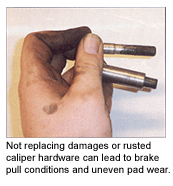
Wheel cylinders should be inspected for torn boots and leaks. After removing the brake shoes, put your thumbs on the pistons. You should be able to push on one piston, moving it inward, while using the other hand to prevent the opposing piston from moving too far and popping out the other end of the wheel cylinder. Both pistons should move smoothly. If not, you have a sticking piston that requires wheel cylinder rebuilding or replacement. Replacement is usually the best option, considering the cost to the customer. A pitted cast iron cylinder can be honed, but an aluminum one cannot.
The entire hydraulic system should be checked for signs of leakage or deterioration. The master cylinder should be dry, as should any proportioning valve. The metallic brake lines should be rust free. Hydraulic hose should not be leaking, twisted or have cracks in their outer sheathing. Defective parts should obviously be replaced.
Often overlooked is the stalwart vacuum booster. Few problems here, as technology hasn’t changed them much over the years. However, they still deserve a quick check.
Pump the brake pedal with the engine off until the brake pedal has a high, hard feel to it. Start the engine while applying foot pressure to the brake pedal. As the engine comes to life and vacuum is applied to the booster, the pedal should drop noticeably. If not, the booster may not be providing adequate boost. Now, remove your foot from the brake pedal, let the engine idle for a few more seconds, then turn it off. Wait a half-minute or so, then pump the brake pedal, counting the number of strokes until the pedal is again high and hard. This should require at least four or five strokes. If not, the booster or vacuum check valve may be leaking vacuum.
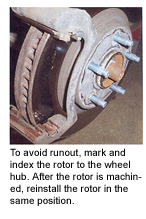 Some vehicles do not use a vacuum booster, instead using hydraulic pressure to provide assist. This hydraulic pressure may come from the power steering pump of the vehicle or from an electric pump that may be integrated with the ABS system. Low pressure in the electrically operated system will likely cause the ABS warning light to come on. Low fluid in the power steering pump-type system will likely cause a familiar pump whine, and also affect the power steering system. Both systems, however, should get a visual inspection for leaks, hose condition and fluid level.
Some vehicles do not use a vacuum booster, instead using hydraulic pressure to provide assist. This hydraulic pressure may come from the power steering pump of the vehicle or from an electric pump that may be integrated with the ABS system. Low pressure in the electrically operated system will likely cause the ABS warning light to come on. Low fluid in the power steering pump-type system will likely cause a familiar pump whine, and also affect the power steering system. Both systems, however, should get a visual inspection for leaks, hose condition and fluid level.
Brake fluid condition should not be disregarded. Many manufacturers now recommend periodic brake fluid flushing and bleeding.
Brake fluid is hygroscopic, meaning it attracts water like desiccant in an air conditioning receiver-drier. This moisture can attack calipers, wheel cylinders, and more importantly, expensive ABS components. Brake fluid can be tested by means of electronic instruments or simple dip-type test strips. If your brake job doesn’t require any hydraulic component replacement, you may want to test and/or replace the brake fluid. If any hydraulic component is being replaced, it would behoove you to flush and bleed the entire system.
Wrapping it Up
Any complete brake job should be finished off with proper bleeding of the system. Besides removing the potentially corrosive brake fluid, you’ll also eliminate any air in the system. Sometimes air will enter the system with no signs of leakage or low fluid level. When drum brakes are used while they are out of adjustment, the relatively long stroke of the piston can cause air to be drawn into the wheel cylinder when the brakes are released.
If you’ve ever installed a wheel cylinder cup in the cylinder backwards, you know that it will leak like the proverbial sieve. The cup acts somewhat like a check valve, so it’s quite possible for a wheel cylinder to “suck” air into itself without leaking fluid.
When the brakes are released, weak return springs may not keep up with the fluid volume as it returns to the master cylinder. This creates a minute vacuum in the wheel cylinder, which can, over many cycles of brake application, draw enough air into the wheel cylinder to create a low or spongy pedal. It’s usually not extremely low or spongy, but enough that bleeding can restore that desired like-new feel.


